2007 ISUZU KB P190 Electrical
[x] Cancel search: ElectricalPage 3867 of 6020
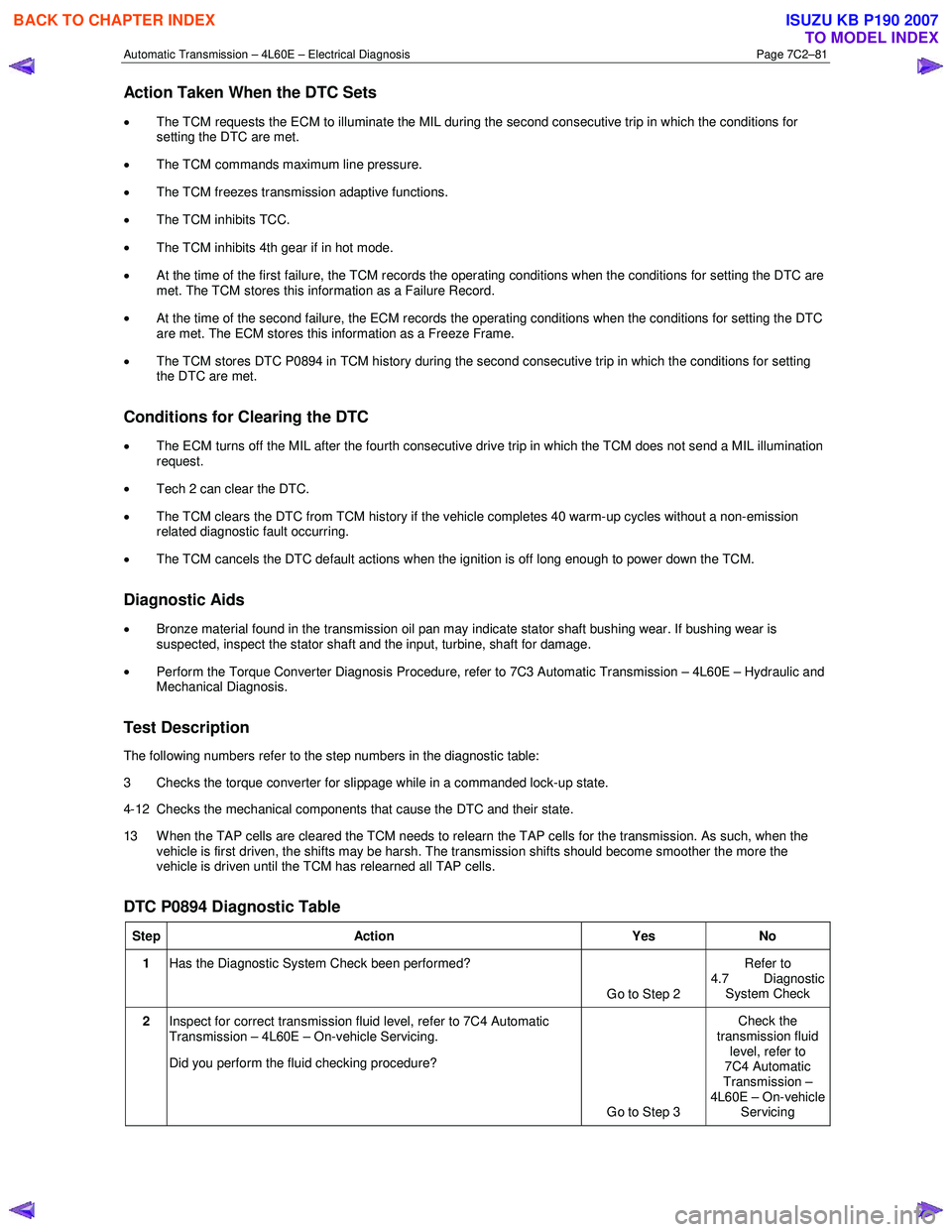
Automatic Transmission – 4L60E – Electrical Diagnosis Page 7C2–81
Action Taken When the DTC Sets
• The TCM requests the ECM to illuminate the MIL during the second consecutive trip in which the conditions for
setting the DTC are met.
• The TCM commands maximum line pressure.
• The TCM freezes transmission adaptive functions.
• The TCM inhibits TCC.
• The TCM inhibits 4th gear if in hot mode.
• At the time of the first failure, the TCM records the operating conditions when the conditions for setting the DTC are
met. The TCM stores this information as a Failure Record.
• At the time of the second failure, the ECM records the operating conditions when the conditions for setting the DTC
are met. The ECM stores this information as a Freeze Frame.
• The TCM stores DTC P0894 in TCM history during the second consecutive trip in which the conditions for setting
the DTC are met.
Conditions for Clearing the DTC
• The ECM turns off the MIL after the fourth consecutive drive trip in which the TCM does not send a MIL illumination
request.
• Tech 2 can clear the DTC.
• The TCM clears the DTC from TCM history if the vehicle completes 40 warm-up cycles without a non-emission
related diagnostic fault occurring.
• The TCM cancels the DTC default actions when the ignition is off long enough to power down the TCM.
Diagnostic Aids
•
Bronze material found in the transmission oil pan may indicate stator shaft bushing wear. If bushing wear is
suspected, inspect the stator shaft and the input, turbine, shaft for damage.
• Perform the Torque Converter Diagnosis Procedure, refer to 7C3 Automatic Transmission – 4L60E – Hydraulic and
Mechanical Diagnosis.
Test Description
The following numbers refer to the step numbers in the diagnostic table:
3 Checks the torque converter for slippage while in a commanded lock-up state.
4-12 Checks the mechanical components that cause the DTC and their state.
13 W hen the TAP cells are cleared the TCM needs to relearn the TAP cells for the transmission. As such, when the vehicle is first driven, the shifts may be harsh. The transmission shifts should become smoother the more the
vehicle is driven until the TCM has relearned all TAP cells.
DTC P0894 Diagnostic Table
Step Action Yes No
1 Has the Diagnostic System Check been performed?
Go to Step 2 Refer to
4.7 Diagnostic System Check
2 Inspect for correct transmission fluid level, refer to 7C4 Automatic
Transmission – 4L60E – On-vehicle Servicing.
Did you perform the fluid checking procedure?
Go to Step 3 Check the
transmission fluid level, refer to
7C4 Automatic
Transmission –
4L60E – On-vehicle Servicing
BACK TO CHAPTER INDEX
TO MODEL INDEX
ISUZU KB P190 2007
Page 3868 of 6020
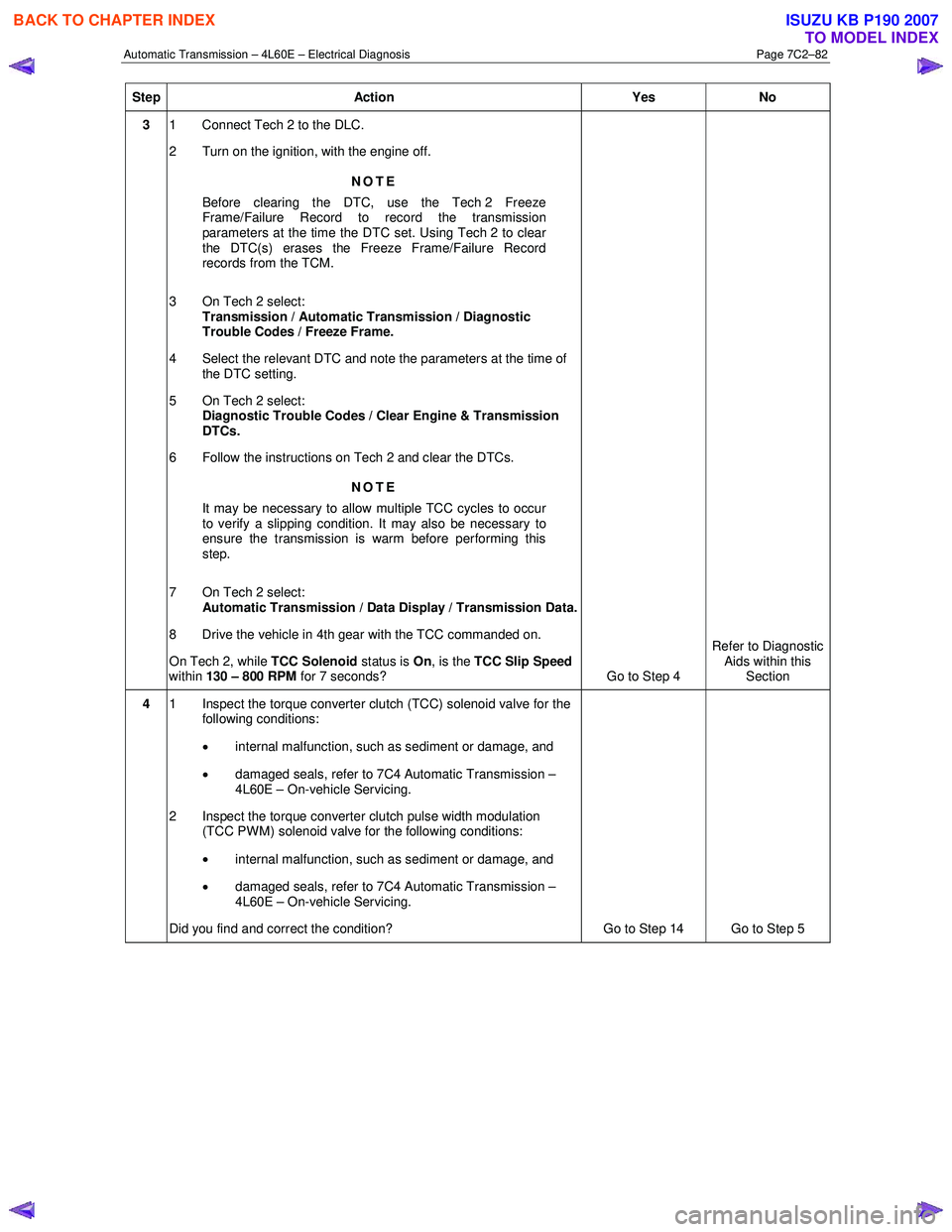
Automatic Transmission – 4L60E – Electrical Diagnosis Page 7C2–82
Step Action Yes No
3 1 Connect Tech 2 to the DLC.
2 Turn on the ignition, with the engine off.
NOTE
Before clearing the DTC, use the Tech 2 Freeze
Frame/Failure Record to record the transmission
parameters at the time the DTC set. Using Tech 2 to clear
the DTC(s) erases the Freeze Frame/Failure Record
records from the TCM.
3 On Tech 2 select: Transmission / Automatic Transmission / Diagnostic
Trouble Codes / Freeze Frame.
4 Select the relevant DTC and note the parameters at the time of the DTC setting.
5 On Tech 2 select:
Diagnostic Trouble Codes / Clear Engine & Transmission
DTCs.
6 Follow the instructions on Tech 2 and clear the DTCs.
NOTE
It may be necessary to allow multiple TCC cycles to occur
to verify a slipping condition. It may also be necessary to
ensure the transmission is warm before performing this
step.
7 On Tech 2 select: Automatic Transmission / Data Display / Transmission Data.
8 Drive the vehicle in 4th gear with the TCC commanded on.
On Tech 2, while TCC Solenoid status is On, is the TCC Slip Speed
within 130 – 800 RPM for 7 seconds?
Go to Step 4 Refer to Diagnostic
Aids within this Section
4 1 Inspect the torque converter clutch (TCC) solenoid valve for the
following conditions:
• internal malfunction, such as sediment or damage, and
• damaged seals, refer to 7C4 Automatic Transmission –
4L60E – On-vehicle Servicing.
2 Inspect the torque converter clutch pulse width modulation (TCC PWM) solenoid valve for the following conditions:
• internal malfunction, such as sediment or damage, and
• damaged seals, refer to 7C4 Automatic Transmission –
4L60E – On-vehicle Servicing.
Did you find and correct the condition? Go to Step 14 Go to Step 5
BACK TO CHAPTER INDEX
TO MODEL INDEX
ISUZU KB P190 2007
Page 3869 of 6020
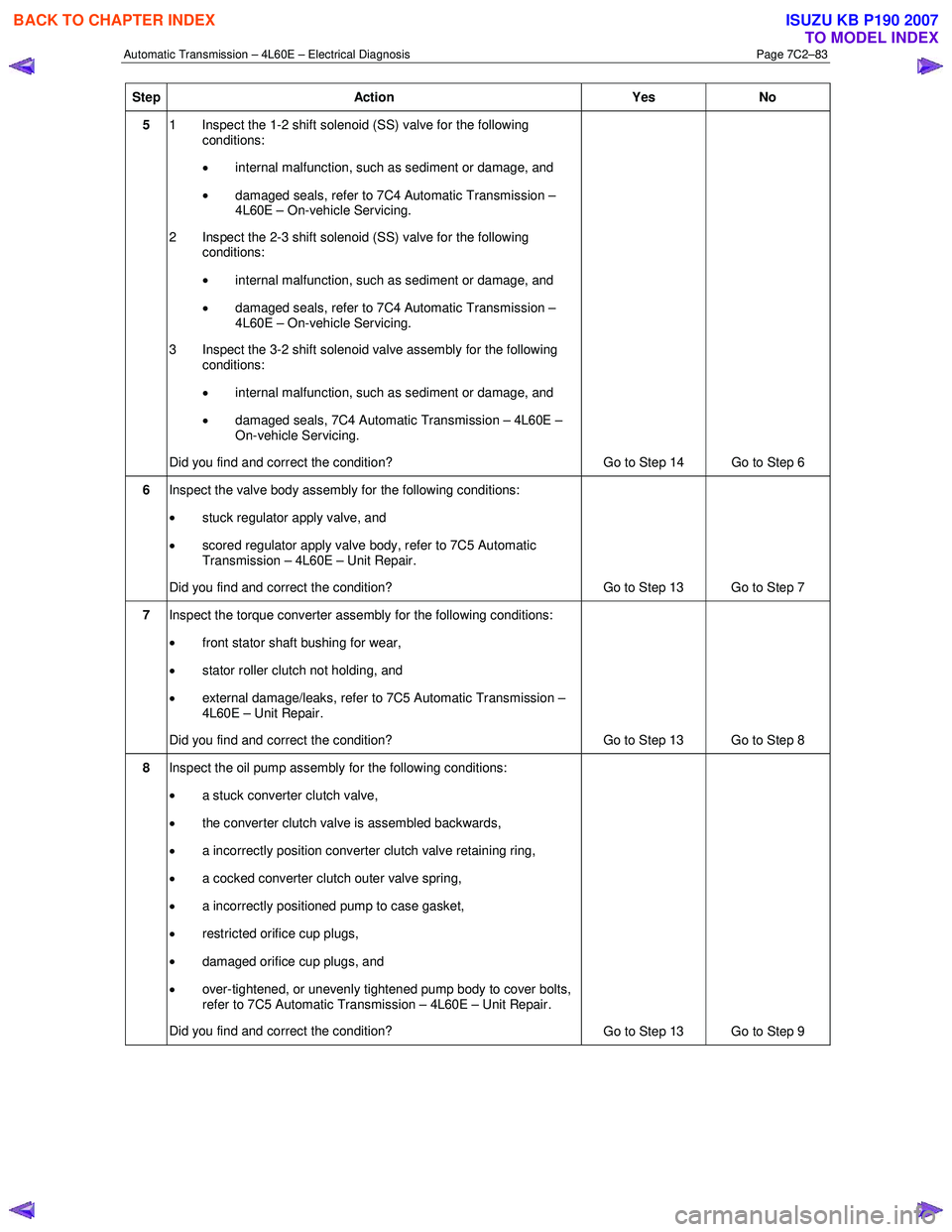
Automatic Transmission – 4L60E – Electrical Diagnosis Page 7C2–83
Step Action Yes No
5 1 Inspect the 1-2 shift solenoid (SS) valve for the following
conditions:
• internal malfunction, such as sediment or damage, and
• damaged seals, refer to 7C4 Automatic Transmission –
4L60E – On-vehicle Servicing.
2 Inspect the 2-3 shift solenoid (SS) valve for the following conditions:
• internal malfunction, such as sediment or damage, and
• damaged seals, refer to 7C4 Automatic Transmission –
4L60E – On-vehicle Servicing.
3 Inspect the 3-2 shift solenoid valve assembly for the following conditions:
• internal malfunction, such as sediment or damage, and
• damaged seals, 7C4 Automatic Transmission – 4L60E –
On-vehicle Servicing.
Did you find and correct the condition? Go to Step 14 Go to Step 6
6 Inspect the valve body assembly for the following conditions:
• stuck regulator apply valve, and
• scored regulator apply valve body, refer to 7C5 Automatic
Transmission – 4L60E – Unit Repair.
Did you find and correct the condition? Go to Step 13 Go to Step 7
7 Inspect the torque converter assembly for the following conditions:
• front stator shaft bushing for wear,
• stator roller clutch not holding, and
• external damage/leaks, refer to 7C5 Automatic Transmission –
4L60E – Unit Repair.
Did you find and correct the condition? Go to Step 13 Go to Step 8
8 Inspect the oil pump assembly for the following conditions:
• a stuck converter clutch valve,
• the converter clutch valve is assembled backwards,
• a incorrectly position converter clutch valve retaining ring,
• a cocked converter clutch outer valve spring,
• a incorrectly positioned pump to case gasket,
• restricted orifice cup plugs,
• damaged orifice cup plugs, and
• over-tightened, or unevenly tightened pump body to cover bolts,
refer to 7C5 Automatic Transmission – 4L60E – Unit Repair.
Did you find and correct the condition? Go to Step 13 Go to Step 9
BACK TO CHAPTER INDEX
TO MODEL INDEX
ISUZU KB P190 2007
Page 3870 of 6020
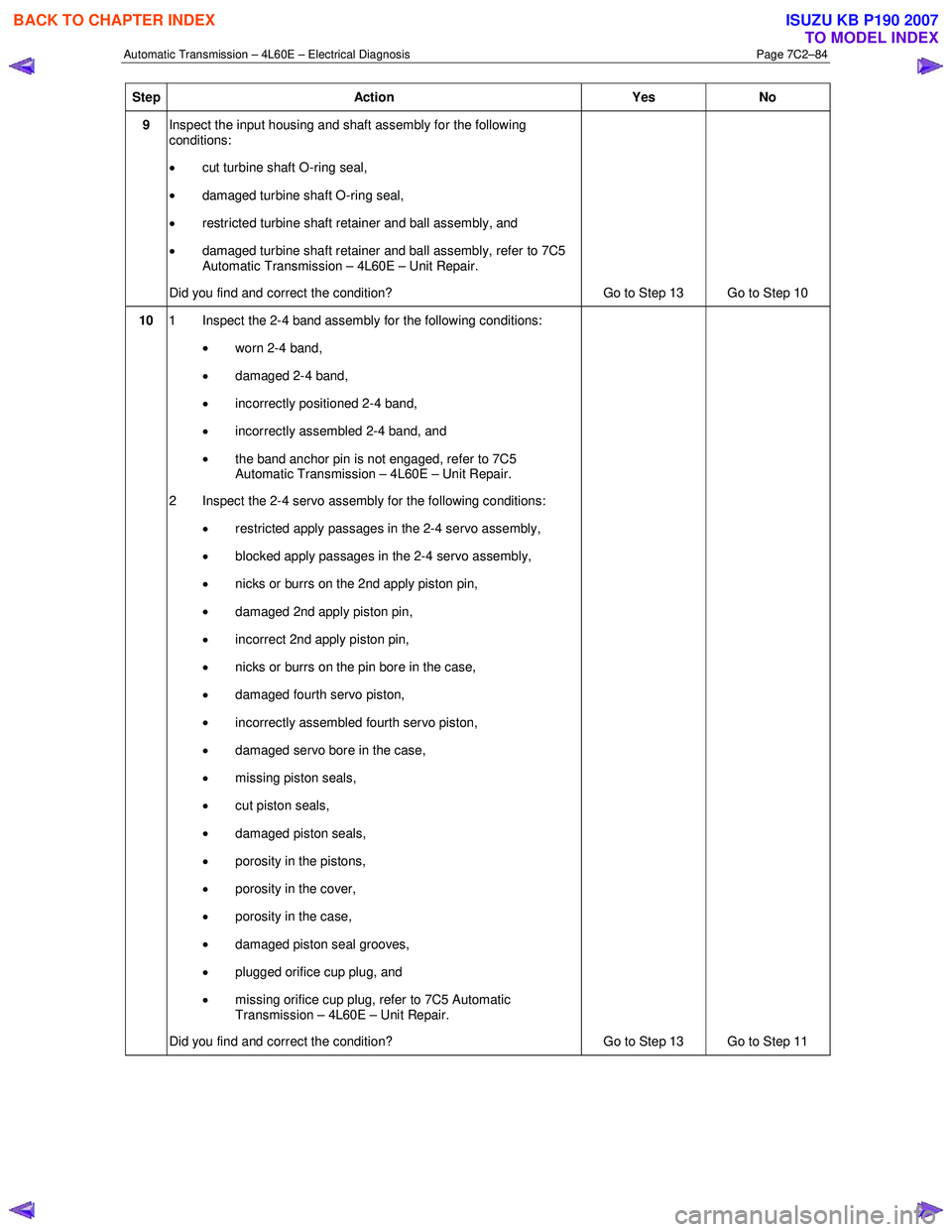
Automatic Transmission – 4L60E – Electrical Diagnosis Page 7C2–84
Step Action Yes No
9 Inspect the input housing and shaft assembly for the following
conditions:
• cut turbine shaft O-ring seal,
• damaged turbine shaft O-ring seal,
• restricted turbine shaft retainer and ball assembly, and
• damaged turbine shaft retainer and ball assembly, refer to 7C5
Automatic Transmission – 4L60E – Unit Repair.
Did you find and correct the condition? Go to Step 13 Go to Step 10
10 1 Inspect the 2-4 band assembly for the following conditions:
• worn 2-4 band,
• damaged 2-4 band,
• incorrectly positioned 2-4 band,
• incorrectly assembled 2-4 band, and
• the band anchor pin is not engaged, refer to 7C5
Automatic Transmission – 4L60E – Unit Repair.
2 Inspect the 2-4 servo assembly for the following conditions:
• restricted apply passages in the 2-4 servo assembly,
• blocked apply passages in the 2-4 servo assembly,
• nicks or burrs on the 2nd apply piston pin,
• damaged 2nd apply piston pin,
• incorrect 2nd apply piston pin,
• nicks or burrs on the pin bore in the case,
• damaged fourth servo piston,
• incorrectly assembled fourth servo piston,
• damaged servo bore in the case,
• missing piston seals,
• cut piston seals,
• damaged piston seals,
• porosity in the pistons,
• porosity in the cover,
• porosity in the case,
• damaged piston seal grooves,
• plugged orifice cup plug, and
• missing orifice cup plug, refer to 7C5 Automatic
Transmission – 4L60E – Unit Repair.
Did you find and correct the condition? Go to Step 13 Go to Step 11
BACK TO CHAPTER INDEX
TO MODEL INDEX
ISUZU KB P190 2007
Page 3871 of 6020
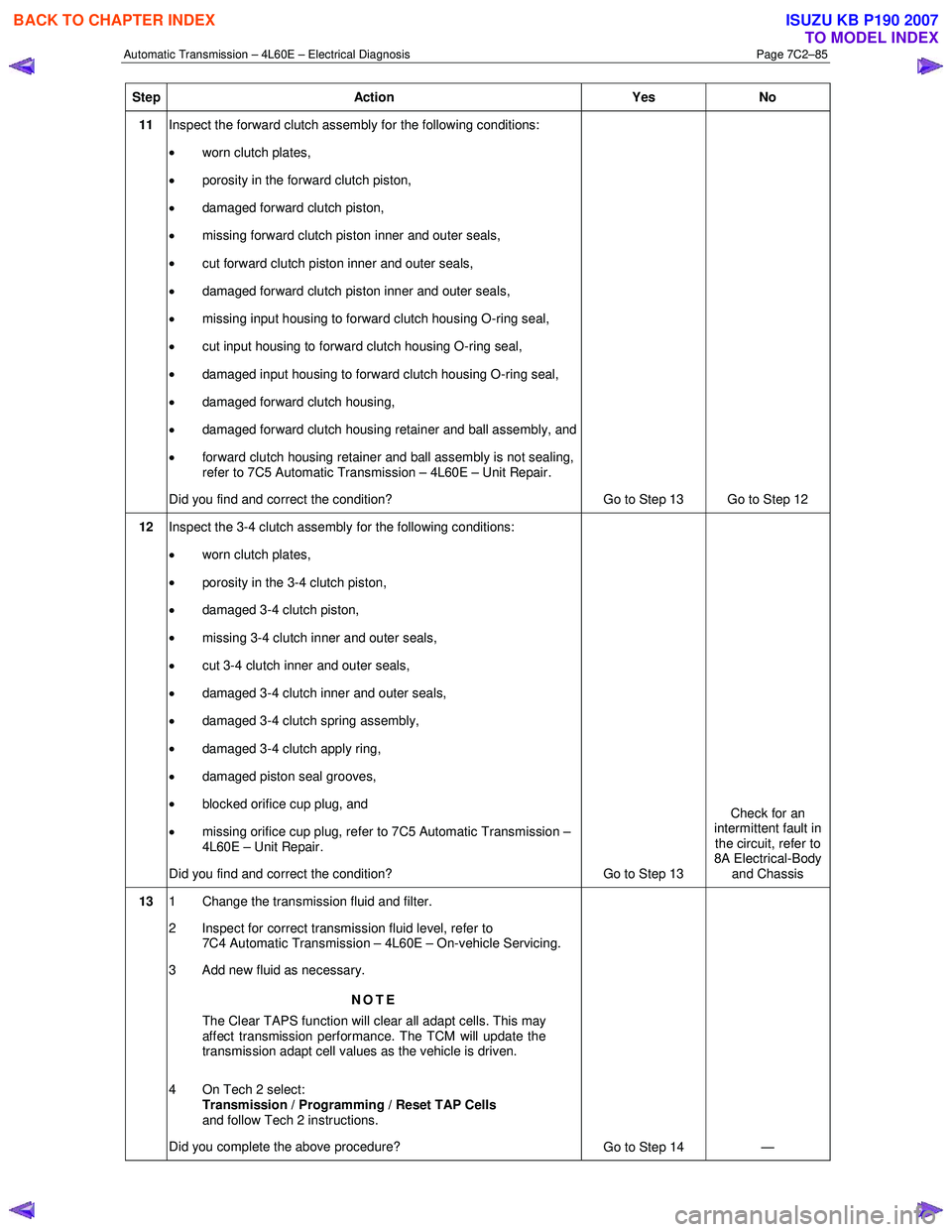
Automatic Transmission – 4L60E – Electrical Diagnosis Page 7C2–85
Step Action Yes No
11 Inspect the forward clutch assembly for the following conditions:
• worn clutch plates,
• porosity in the forward clutch piston,
• damaged forward clutch piston,
• missing forward clutch piston inner and outer seals,
• cut forward clutch piston inner and outer seals,
• damaged forward clutch piston inner and outer seals,
• missing input housing to forward clutch housing O-ring seal,
• cut input housing to forward clutch housing O-ring seal,
• damaged input housing to forward clutch housing O-ring seal,
• damaged forward clutch housing,
• damaged forward clutch housing retainer and ball assembly, and
• forward clutch housing retainer and ball assembly is not sealing,
refer to 7C5 Automatic Transmission – 4L60E – Unit Repair.
Did you find and correct the condition? Go to Step 13 Go to Step 12
12 Inspect the 3-4 clutch assembly for the following conditions:
• worn clutch plates,
• porosity in the 3-4 clutch piston,
• damaged 3-4 clutch piston,
• missing 3-4 clutch inner and outer seals,
• cut 3-4 clutch inner and outer seals,
• damaged 3-4 clutch inner and outer seals,
• damaged 3-4 clutch spring assembly,
• damaged 3-4 clutch apply ring,
• damaged piston seal grooves,
• blocked orifice cup plug, and
• missing orifice cup plug, refer to 7C5 Automatic Transmission –
4L60E – Unit Repair.
Did you find and correct the condition? Go to Step 13 Check for an
intermittent fault in the circuit, refer to
8A Electrical-Body and Chassis
13 1 Change the transmission fluid and filter.
2 Inspect for correct transmission fluid level, refer to 7C4 Automatic Transmission – 4L60E – On-vehicle Servicing.
3 Add new fluid as necessary.
NOTE
The Clear TAPS function will clear all adapt cells. This may
affect transmission performance. The TCM will update the
transmission adapt cell values as the vehicle is driven.
4 On Tech 2 select: Transmission / Programming / Reset TAP Cells
and follow Tech 2 instructions.
Did you complete the above procedure? Go to Step 14 —
BACK TO CHAPTER INDEX
TO MODEL INDEX
ISUZU KB P190 2007
Page 3872 of 6020
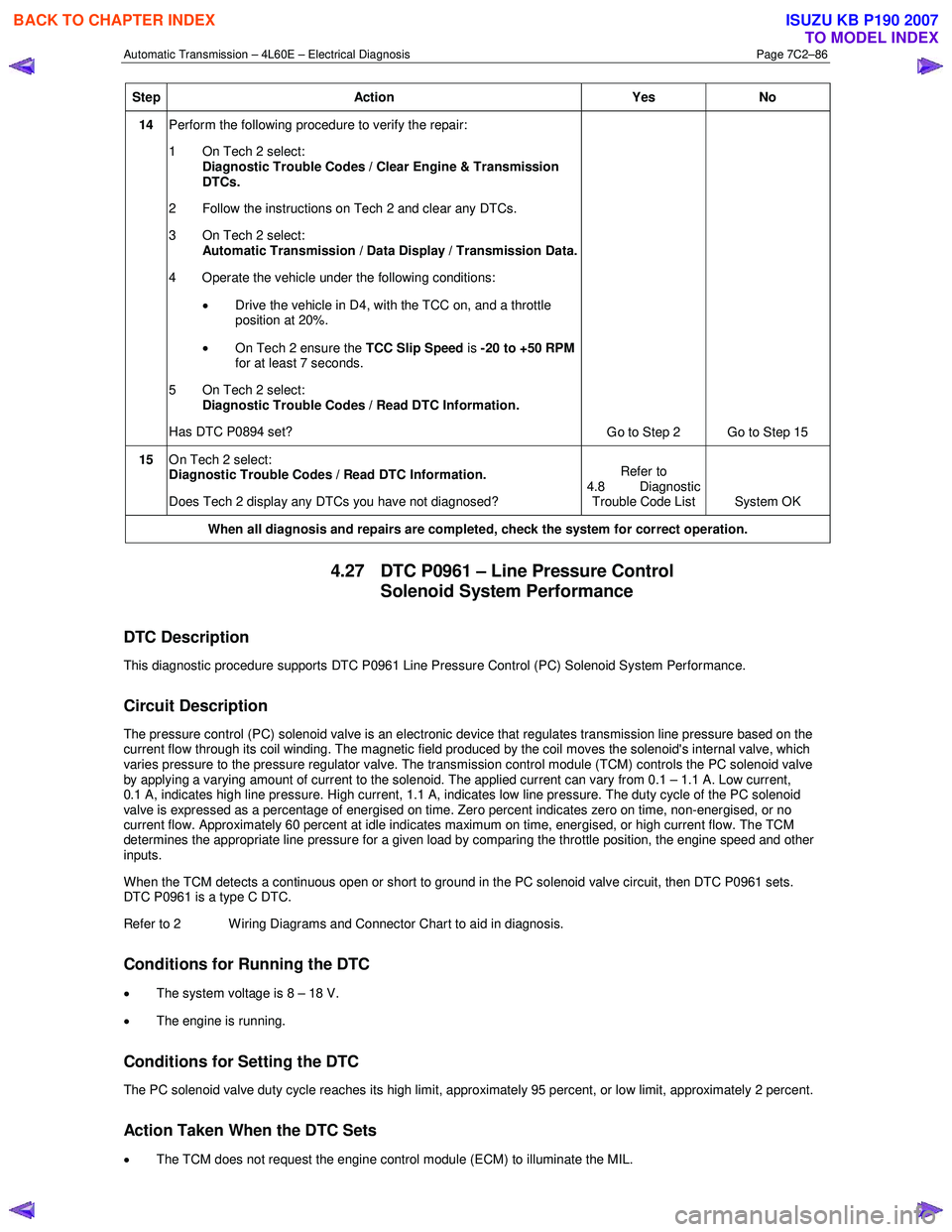
Automatic Transmission – 4L60E – Electrical Diagnosis Page 7C2–86
Step Action Yes No
14 Perform the following procedure to verify the repair:
1 On Tech 2 select: Diagnostic Trouble Codes / Clear Engine & Transmission
DTCs.
2 Follow the instructions on Tech 2 and clear any DTCs.
3 On Tech 2 select: Automatic Transmission / Data Display / Transmission Data.
4 Operate the vehicle under the following conditions:
• Drive the vehicle in D4, with the TCC on, and a throttle
position at 20%.
• On Tech 2 ensure the TCC Slip Speed is -20 to +50 RPM
for at least 7 seconds.
5 On Tech 2 select:
Diagnostic Trouble Codes / Read DTC Information.
Has DTC P0894 set? Go to Step 2 Go to Step 15
15 On Tech 2 select:
Diagnostic Trouble Codes / Read DTC Information.
Does Tech 2 display any DTCs you have not diagnosed? Refer to
4.8 Diagnostic Trouble Code List System OK
When all diagnosis and repairs are completed, check the system for correct operation.
4.27 DTC P0961 – Line Pressure Control
Solenoid System Performance
DTC Description
This diagnostic procedure supports DTC P0961 Line Pressure Control (PC) Solenoid System Performance.
Circuit Description
The pressure control (PC) solenoid valve is an electronic device that regulates transmission line pressure based on the
current flow through its coil winding. The magnetic field produced by the coil moves the solenoid's internal valve, which
varies pressure to the pressure regulator valve. The transmission control module (TCM) controls the PC solenoid valve
by applying a varying amount of current to the solenoid. The applied current can vary from 0.1 – 1.1 A. Low current,
0.1 A, indicates high line pressure. High current, 1.1 A, indicates low line pressure. The duty cycle of the PC solenoid
valve is expressed as a percentage of energised on time. Zero percent indicates zero on time, non-energised, or no
current flow. Approximately 60 percent at idle indicates maximum on time, energised, or high current flow. The TCM
determines the appropriate line pressure for a given load by comparing the throttle position, the engine speed and other
inputs.
W hen the TCM detects a continuous open or short to ground in the PC solenoid valve circuit, then DTC P0961 sets.
DTC P0961 is a type C DTC.
Refer to 2 W iring Diagrams and Connector Chart to aid in diagnosis.
Conditions for Running the DTC
• The system voltage is 8 – 18 V.
• The engine is running.
Conditions for Setting the DTC
The PC solenoid valve duty cycle reaches its high limit, approximately 95 percent, or low limit, approximately 2 percent.
Action Taken When the DTC Sets
• The TCM does not request the engine control module (ECM) to illuminate the MIL.
BACK TO CHAPTER INDEX
TO MODEL INDEX
ISUZU KB P190 2007
Page 3873 of 6020

Automatic Transmission – 4L60E – Electrical Diagnosis Page 7C2–87
• The TCM records the operating conditions when the conditions for setting the DTC are met. The TCM records this
information as a Failure Record.
• The TCM freezes transmission adaptive functions.
• The TCM commands maximum line pressure.
• The TCM stores DTC P0961 in TCM history.
Conditions for Clearing the DTC
• The TCM clears the DTC from TCM history if the vehicle completes 40 warm-up cycles without a non-emission
related diagnostic fault occurring.
• Tech 2 can clear the DTC.
Diagnostic Aids
DTC P0961 may set under low voltage conditions caused by high electrical system demands.
Test Description
The following numbers refer to the step numbers in the diagnostic table:
2 Checks the ability of the TCM to control the solenoid.
3 Checks the resistance of the control valve body wiring harness and the PC solenoid.
5 Checks the serviceability of the PC solenoid circuits contained in the control valve body wiring harness.
6-8 Checks the serviceability the power and signal circuits between the TCM and the transmission.
DTC P0961 Diagnostic Table
Step Action Yes No
1 Has the Diagnostic System Check been performed?
Go to Step 2 Refer to
4.7 Diagnostic
System Check
BACK TO CHAPTER INDEX
TO MODEL INDEX
ISUZU KB P190 2007
Page 3874 of 6020
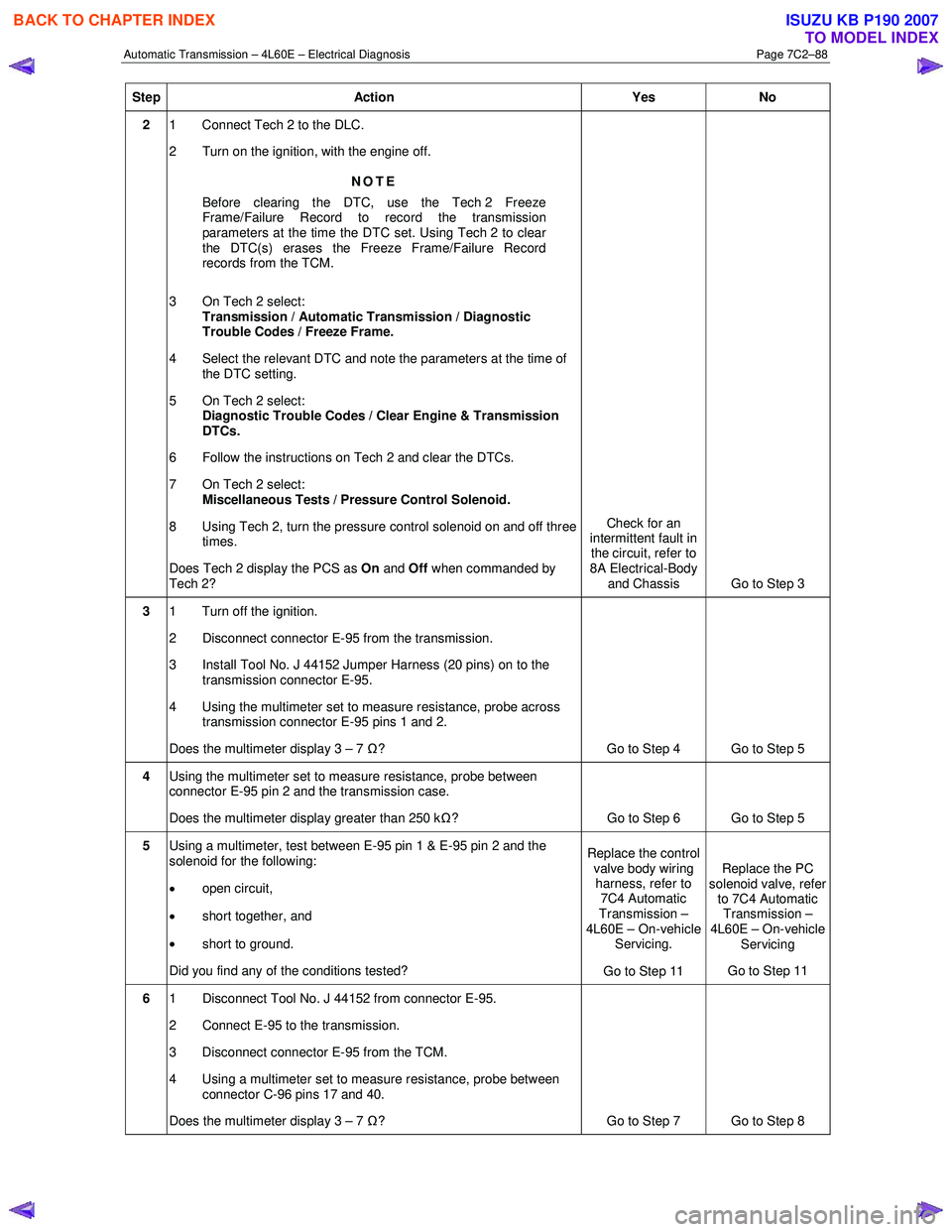
Automatic Transmission – 4L60E – Electrical Diagnosis Page 7C2–88
Step Action Yes No
2 1 Connect Tech 2 to the DLC.
2 Turn on the ignition, with the engine off.
NOTE
Before clearing the DTC, use the Tech 2 Freeze
Frame/Failure Record to record the transmission
parameters at the time the DTC set. Using Tech 2 to clear
the DTC(s) erases the Freeze Frame/Failure Record
records from the TCM.
3 On Tech 2 select: Transmission / Automatic Transmission / Diagnostic
Trouble Codes / Freeze Frame.
4 Select the relevant DTC and note the parameters at the time of the DTC setting.
5 On Tech 2 select:
Diagnostic Trouble Codes / Clear Engine & Transmission
DTCs.
6 Follow the instructions on Tech 2 and clear the DTCs.
7 On Tech 2 select: Miscellaneous Tests / Pressure Control Solenoid.
8 Using Tech 2, turn the pressure control solenoid on and off three times.
Does Tech 2 display the PCS as On and Off when commanded by
Tech 2? Check for an
intermittent fault in the circuit, refer to
8A Electrical-Body and Chassis Go to Step 3
3 1 Turn off the ignition.
2 Disconnect connector E-95 from the transmission.
3 Install Tool No. J 44152 Jumper Harness (20 pins) on to the transmission connector E-95.
4 Using the multimeter set to measure resistance, probe across transmission connector E-95 pins 1 and 2.
Does the multimeter display 3 – 7 Ω? Go to Step 4 Go to Step 5
4 Using the multimeter set to measure resistance, probe between
connector E-95 pin 2 and the transmission case.
Does the multimeter display greater than 250 k Ω? Go to Step 6 Go to Step 5
5 Using a multimeter, test between E-95 pin 1 & E-95 pin 2 and the
solenoid for the following:
• open circuit,
• short together, and
• short to ground.
Did you find any of the conditions tested? Replace the control
valve body wiring harness, refer to 7C4 Automatic
Transmission –
4L60E – On-vehicle Servicing.
Go to Step 11 Replace the PC
solenoid valve, refer to 7C4 Automatic
Transmission –
4L60E – On-vehicle Servicing
Go to Step 11
6 1 Disconnect Tool No. J 44152 from connector E-95.
2 Connect E-95 to the transmission.
3 Disconnect connector E-95 from the TCM.
4 Using a multimeter set to measure resistance, probe between connector C-96 pins 17 and 40.
Does the multimeter display 3 – 7 Ω? Go to Step 7 Go to Step 8
BACK TO CHAPTER INDEX
TO MODEL INDEX
ISUZU KB P190 2007